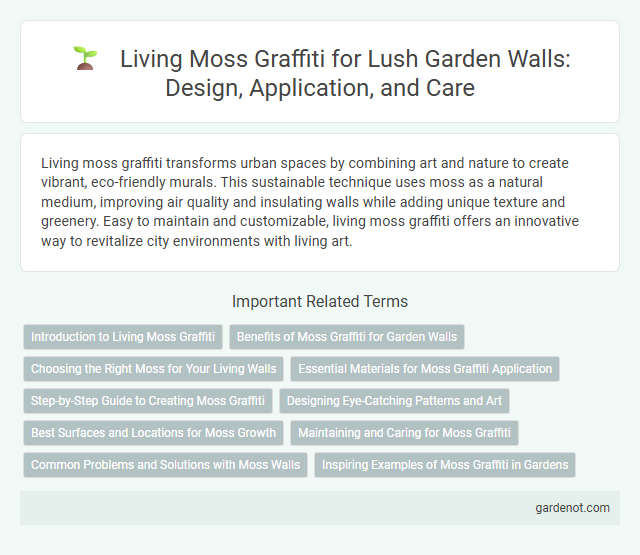Living moss graffiti transforms urban spaces by combining art and nature to create vibrant, eco-friendly murals. This sustainable technique uses moss as a natural medium, improving air quality and insulating walls while adding unique texture and greenery. Easy to maintain and customizable, living moss graffiti offers an innovative way to revitalize city environments with living art.
Introduction to Living Moss Graffiti
Living moss graffiti transforms urban spaces using sustainable, eco-friendly moss cultures applied to walls, promoting green art and biodiversity. This innovative form of street art relies on various moss species that naturally thrive on vertical surfaces, absorbing carbon and improving air quality. As a low-maintenance, biodegradable alternative to traditional graffiti, living moss graffiti supports environmental awareness and urban ecosystem health.
Benefits of Moss Graffiti for Garden Walls
Living moss graffiti enhances garden walls by improving air quality through natural carbon dioxide absorption while providing a vibrant, eco-friendly aesthetic that supports urban biodiversity. Its low maintenance requirements and natural insulation properties help regulate wall temperature, reducing energy costs. Moss also promotes humidity control and noise reduction, creating a healthier, more serene garden environment.
Choosing the Right Moss for Your Living Walls
Selecting the right moss species for living moss graffiti involves considering factors such as light exposure, humidity levels, and wall texture to ensure optimal growth and longevity. Species like cushion moss (Leucobryum glaucum) thrive in shaded, moist environments, while sheet moss (Hypnum cupressiforme) prefers moderate light and humidity, making them ideal candidates for living walls. Understanding these specific environmental needs helps create vibrant, sustainable living walls that enhance aesthetic appeal and air quality.
Essential Materials for Moss Graffiti Application
Essential materials for living moss graffiti application include a blend of moss species suited to the local climate, a nutrient-rich substrate such as yogurt or buttermilk mixed with water and natural binders like corn syrup or beer, and tools like a blender to create the moss slurry. The selection of moss and substrate impacts the graffiti's longevity and vibrancy, while application tools aid in precise placement and adherence on surfaces. Proper preparation of the wall, including cleaning and ensuring moisture retention, is critical for the moss to thrive and establish growth.
Step-by-Step Guide to Creating Moss Graffiti
Creating moss graffiti involves blending moss with water, yogurt, and sugar to form a paste that can be applied to surfaces. Select a shaded, porous wall for optimal moss growth and use a brush or stencil to shape the design. Maintain moisture by misting daily and monitor for moss establishment over 1 to 3 weeks.
Designing Eye-Catching Patterns and Art
Living moss graffiti transforms urban spaces with vibrant, eco-friendly art by incorporating natural textures and rich green hues into wall designs. Designers use various moss species to create intricate, lasting patterns that thrive in diverse environmental conditions, enhancing both aesthetics and air quality. Strategic placement and maintenance ensure the moss art remains visually striking while promoting sustainability in urban landscapes.
Best Surfaces and Locations for Moss Growth
Ideal surfaces for living moss graffiti include porous materials such as concrete, brick, and untreated wood that retain moisture and encourage moss adhesion. Shaded, humid environments like garden walls, urban alleyways, and the north-facing sides of buildings support optimal moss growth by preventing drying and promoting sustained hydration. Selecting locations with minimal direct sunlight and stable temperatures enhances moss vitality and longevity in living wall installations.
Maintaining and Caring for Moss Graffiti
Maintaining and caring for moss graffiti involves regular misting to ensure consistent moisture, as moss thrives in humid environments and can dry out quickly. It is essential to place the living wall in a shaded or partially shaded area to prevent direct sunlight, which can damage the moss and hinder its growth. Periodic trimming and gentle cleaning remove debris and promote healthy, vibrant moss coverage, extending the lifespan and aesthetic appeal of the living moss graffiti.
Common Problems and Solutions with Moss Walls
Living moss graffiti often faces challenges such as moisture retention, uneven growth, and susceptibility to pests or mold. Maintaining optimal humidity levels and using high-quality, resilient moss species can promote uniform growth and longevity. Regular cleaning and careful monitoring prevent pest infestations and ensure vibrant, healthy moss walls.
Inspiring Examples of Moss Graffiti in Gardens
Living moss graffiti transforms garden spaces into vibrant, eco-friendly art installations by using resilient, natural moss to create intricate designs on walls and rocks. Examples such as Patrick Blanc's vertical gardens and urban moss murals demonstrate how moss thrives in diverse environments, enhancing aesthetic appeal while promoting biodiversity. These installations require minimal maintenance and support sustainable gardening practices by improving air quality and fostering habitat for microfauna.
Living moss graffiti Infographic

 gardenot.com
gardenot.com